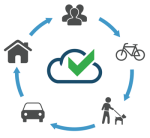So today is the final day of my placement here at the studio, and it is very sad indeed.
These last six weeks have really given me a good insight into the real working world, away from university. The Studio has been the perfect place for me to learn about the steps needed for a small start-up business, and the team here have also taught me, through their experiences, the attitude I’d need to have when working for a large agency.To summarise the last six weeks, I have written the 10 best things I’ve learned whilst on placement here:
- Knowing your audience; to design a product that meets the needs of the right audience, it is important to know who you are trying to reach. Simple exercises such as creating a survey and making sure the tone is correct for the audience, really helped me to understand that in business you can never assume your target market, and the personas you are aiming your products at.
- Planning is vital; to run an efficient project from start to finish, there needs to be a lot or organising. Tools such as ‘Kanban’ boards, which I’d learned from an educational point of view, are in fact a massive aid in the physical work place. Every week Si leads the team through planning what they need to achieve by the end of the week, planning out each day and setting goals in accordance to project deadlines.
- Bradford City is the best team in Europe due to maths. Maths proved that:
Bayern Munich > Barcelona
Chelsea > Bayern Munich
Bradford City > Chelsea
Therefore – Bradford City > Chelsea > Bayern Munich > Barcelona
Or something… - Professional doesn’t necessarily mean formal. Often, the best way to build relationships with clients is to be relaxed, professional, but friendly and not overly manicured. This is something the team do really well here, and you can see from their relaxed and calm approach with clients the relationship is in fact more trusting and therefore more efficient.
- Communication is key; both amongst the team and between client and company.
In order to build trust with a client it is important to keep them in the loop, and make sure that the product you are delivering serves the purpose the client wants. - There is so much going on outside of the work place, which can further your network and knowledge in Leeds, and it’d be madness not to attend.
- When writing a brief, communication and tone is massively important. Instead of writing a brief how we think it in our heads; we must write the brief in a tone that the intended person/s will understand. A brief that is in the wrong tone can lead to miss understanding, lack of communication and an all-round disaster, especially in a large company.
- To run a small business, you have to be able to understand and turn your hand to all aspects of a large company; such as the legalities, financial, psychological, team management, secretarial, human resources and everything else. Therefore it’s worth having a brief understanding of all these elements that it takes to run a business.
- Data is gold dust; as I experienced during my stay here data can change the entire focus of the project to suit customer needs. As I experienced with the results of the survey, several small changes to a website can change the tone and therefore appeal to a wider audience. This can help convert sales and make for a better user experience.
- Most importantly, I have learned how important it is to get experience of a real work environment, and although you learn skills through university, nothing can set you up for the working environment more than experiencing it. Volunteering and gaining experience whilst at university gives you the opportunity to transfer the skills you’re learning into a real practical situation.
I just want to take this opportunity to thank the team at Studio of Things for making me feel so welcome, helping me understand the work environment and taking the time to teach me these things which will without a doubt set me up for the future work place. Cheers guys





